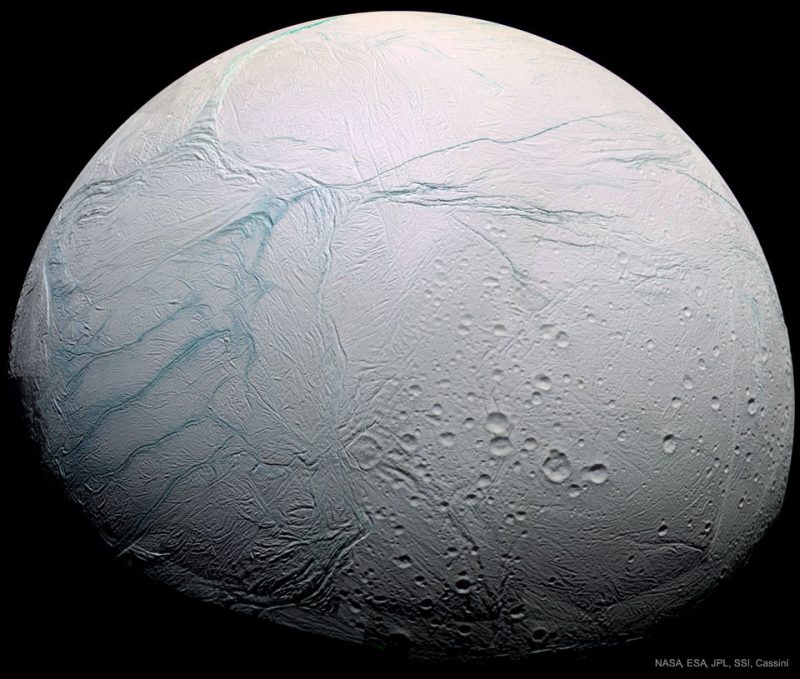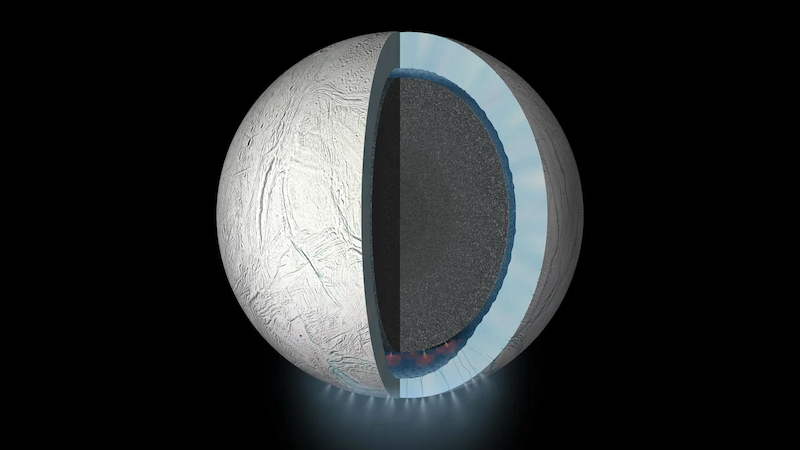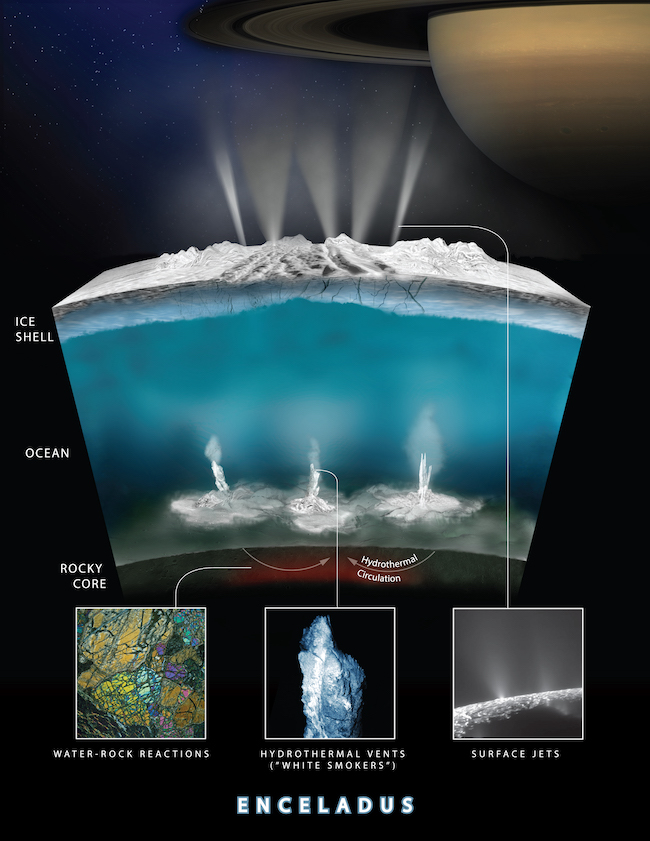
With its global subsurface water ocean, Saturn’s moon Enceladus is considered to be one of the best places to search for life. Now, new research from a team of biologists suggests life on Enceladus might indeed be quite possible … and that we might already have evidence for it. Something is producing a lot of methane on Enceladus, or rather in its subsurface ocean. And methane can be a life sign. Charlie Wood discussed these curious results on June 8, 2021, in Popular Science. Intriguingly, according to Wood’s article, initial analysis suggests the methane is being produced in a way similar to methanogenic microbes in oceans on Earth.
This isn’t proof yet of life on, or rather in, Enceladus, but it certainly is interesting.
The peer-reviewed findings were published on June 8, 2021, in Nature Astronomy.
Methane on Enceladus: Hydrothermal vents and methanogens
The original methane detection is from analysis of data obtained by the Cassini spacecraft. The probe made several close flybys of the moon. At one point, it flew right through water vapor plumes erupting through cracks at Enceladus’ south pole. The water vapor in the plumes comes from the ocean deep below the icy outer surface.
Also, Cassini found ice particles, salts, hydrogen and organic molecules in the plumes, tentative hints of an ocean that is similar to Earth’s oceans in composition. There is also evidence for hydrothermal vents on Enceladus’ seafloor, similar to those that support methanogens in Earth’s oceans. As outlined in the abstract of the paper:
Observations from NASA’s Cassini spacecraft established that Saturn’s moon Enceladus has an internal liquid ocean. Analysis of a plume of ocean material ejected into space suggests that alkaline hydrothermal vents are present on Enceladus’s seafloor. On Earth, such deep-sea vents harbor microbial ecosystems rich in methanogenic archaea.

So, what is producing the methane on Enceladus?
Scientists already knew the methane existed, but the new study shows that the surprisingly large amount of it is difficult to explain. Basically, the most likely chemical process that could produce methane on Enceladus, serpentinization, wouldn’t be able to create nearly as much as is being observed. So what could? As Antonin Affholder, at ENS Paris and lead author, told Popular Science:
Methanogens are able to explain the amount of methane.

Methanogens are microbial life forms that eat hydrogen and carbon dioxide and produce methane as a byproduct. On Earth, they are found at deep sea hydrothermal vents like the ones thought to exist on Enceladus’ seafloor.
So, could this really be the explanation for the methane on Enceladus?
Biological or non-biological?
With this in mind, the researchers considered all the possible scenarios where methane could be produced in Enceladus’ ocean. In serpentization, the interaction of hot water and minerals in rocks can create hydrogen. Subsequently, chemical reactions can then combine the hydrogen and carbon dioxide to produce methane.
It sounded plausible, so the researchers looked closer at the possibility. They wanted to see just how much methane could realistically be produced this way on Enceladus. They then compared those results, using Bayesian analysis, to a scenario where methanogens were involved. In fact, the researchers used real organisms on Earth for the comparison. Overall, it was important to keep their expectations realistic, as Affholder explained:
We cannot just imagine whatever we want to imagine. We have to ground assumptions in what we know.

‘Too much’ methane
The results were surprising: the amount of methane detected by Cassini was significantly higher than could be easily explained by serpentization alone. Affholder said:
The first hypothesis is completely disqualified, score of zero.
As outlined in the abstract, there was apparently “too much” methane to be easily explained only by inorganic chemistry. From the abstract:
Here we use a Bayesian statistical approach to quantify the probability that methanogenesis (biotic methane production) might explain the escape rates of molecular hydrogen and methane in Enceladus’s plume, as measured by Cassini instruments.
We find that the observed escape rates (1) cannot be explained solely by the abiotic alteration of the rocky core by serpentinization; (2) are compatible with the hypothesis of habitable conditions for methanogens; and (3) score the highest likelihood under the hypothesis of methanogenesis, assuming that the probability of life emerging is high enough.
Too much hydrogen?
In addition, Cassini also found an abundance of hydrogen in the ocean, which could be used as a food source for the microbes. But, there seemed to be more of it left over then there should be if it was being consumed as food. As it turns out, there might be an answer for that mystery, too. Most of the hydrogen molecules are thought to be very close to the vents, where it would be too hot for the methanogens. Instead, the organisms could feast on hydrogen molecules that are farther away from the vents. In that scenario, there would be little impact on the overall abundance of hydrogen.

More data needed
Serpentization, at least by itself, seems to be an unlikely solution to the methane mystery. It’s still possible there could be an excess of primordial methane, left over from Enceladus’ formation, that’s bubbling up from its core. Or another still-unknown process at work. As Affholder points out, we still don’t know enough about Enceladus to know for sure:
We don’t know the origin of Enceladus. We don’t know the age of Enceladus. We don’t know the precise nature of the methane. To know more, we might need a mission to examine methane.
In short, answering these questions will require more data. Unfortunately, no return missions have been planned as of yet. Cassini analyzed the plumes in great detail, but it goes without saying that a probe that could specifically look for evidence of life itself in them would be even better. Here’s hoping!
Bottom line: Something is producing a lot of methane in Enceladus’ ocean. Could it be life? While not proven yet, a new study by a team of biologists seems to support that exciting possibility.
Source: Bayesian analysis of Enceladus’s plume data to assess methanogenesis











